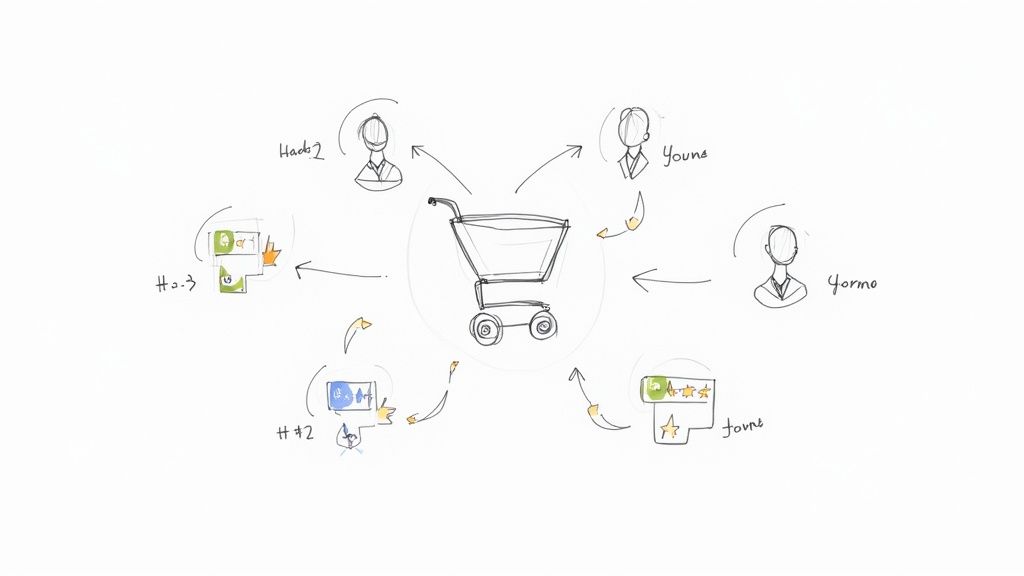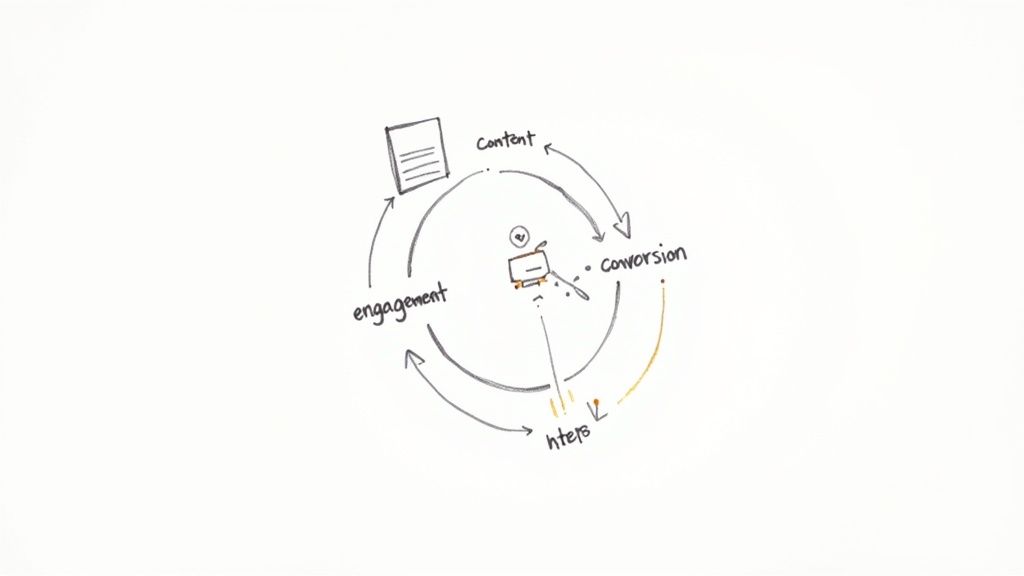Ecommerce Social Proof: Boost Trust & Conversions

21 mins
6/2/2025
Joe Ervin
- ecommerce social proof
- social proof
- ecommerce marketing
- customer reviews
- online trust
Why Trust Matters in Ecommerce
Trust is key for online sales. People buy when they feel understood and see others value your product. This is ecommerce social proof. It shows shoppers they're not alone and that your brand delivers. This list gives you eight ways to build trust and turn doubters into loyal customers using ecommerce social proof. Learn how to use customer reviews, user-generated content, and more to grow your brand.
1. Customer Reviews and Ratings
Customer reviews and ratings are the foundation of ecommerce social proof. They show real experiences from real buyers. These reviews, often with star ratings, live on product pages. This helps shoppers decide if a product is right for them. They can see what other people think before they buy. Trust is key for online sales. People need to feel understood and believe what you say. Showing that others value your product builds that trust. Online, shoppers don't automatically trust you. You must earn it. Reviews and ratings help you do this. When shoppers see you've helped people like them, they're more likely to buy from you.

Think of customer reviews like a friend recommending something. Would you trust a friend more than an advertisement? Most people would. Features like star ratings (1 to 5 stars), written reviews, photos, and videos make this social proof powerful. "Verified purchase" badges add even more trust. Shoppers can filter and sort reviews to find information important to them. You, the seller, can also respond to reviews, showing you care.
Sites like Amazon, Sephora, and Best Buy show how reviews work well. Amazon uses verified purchases to show real reviews. Sephora lets shoppers filter beauty reviews by skin tone and type. Best Buy combines expert and customer reviews. These companies understand that reviews help sales.
Customer reviews and ratings offer many advantages:
- More Sales: Reviews can boost sales by 15-20%.
- Trust Building: Reviews show you're honest and reliable.
- Product Feedback: Learn what people like and dislike about your products.
- Better SEO: Fresh content from reviews helps search engines find your products.
- Fewer Returns: Clear descriptions and real reviews help set the right expectations.
There are a few downsides, too:
- Negative Reviews: Bad reviews can hurt sales.
- Review Management: You need to watch for fake reviews and answer real ones.
- Time Investment: Building lots of reviews takes time.
You can get more reviews with these simple tips:
- Email Reminders: Send emails 7-14 days after purchase asking for a review.
- Small Rewards: Offer a small discount for an honest review.
- Respond to Reviews: Answer both good and bad reviews professionally.
- Show Average Ratings: Display star ratings in search results and on product listings.
- Use Review Widgets: Show reviews on category pages for more social proof.
Learn more about Customer Reviews and Ratings (Note: While this link points to customer loyalty programs, it's the closest available resource provided and can offer related insights.)
Customer reviews and ratings deserve a top spot on any ecommerce social proof list. They are a simple, powerful way to build trust and grow your business. For brands selling skincare or clothing, customer reviews are especially helpful. People want to know how products work for others with similar skin or body types. This honest feedback can make a big difference in a shopper's decision. Remember, trust is everything in ecommerce. Reviews are a key part of building that trust.
2. User-Generated Content (UGC)
User-generated content (UGC) is like word-of-mouth, but online. It's real people sharing their experiences with your products. Think photos, videos, and posts showing how they use your items in everyday life. UGC is powerful because it shows potential customers that real people, just like them, enjoy your products. This builds trust, which is the key to selling online. Customers are naturally skeptical. UGC helps overcome that skepticism by showing, not just telling, how great your products are. It makes your brand relatable and trustworthy.

Think about it: you’re more likely to trust a friend's recommendation than an advertisement, right? UGC works the same way. It’s authentic and comes from real experiences, unlike branded content which can feel fake or pushy. For ecommerce brands, especially those selling skincare or clothing, trust is everything. People need to trust that your products work and that you understand their needs. UGC bridges this trust gap. When you showcase other happy customers, you’re showing potential buyers that you’ve helped people just like them. This transforms doubters into believers, and believers into loyal customers.
UGC includes things like customer photos and videos on your product pages, social media posts with your branded hashtag, and even entire galleries dedicated to customer content. You can create contests and campaigns to encourage customers to create and share their experiences. Some companies even have special sections on their websites where customers can connect and share.
Successful brands like GoPro, Glossier, and Airbnb use UGC effectively. GoPro showcases customer adventure videos, Glossier integrates customer selfies onto product pages, and Airbnb encourages hosts and guests to share photos. Starbucks' seasonal cup photo campaigns are another great example. These companies understand that showing real people enjoying their products is more persuasive than any advertisement.
While UGC offers many benefits, there are a few challenges. Maintaining quality control can be tricky. You also need to be careful about usage rights and get permission before using customer content. It can be difficult to maintain a consistent flow of UGC, and there's always the risk of off-brand or inappropriate content. However, the benefits far outweigh the challenges.
Here are some tips to effectively use UGC:
- Create a branded hashtag: Make it easy for customers to share their experiences. Promote your hashtag actively on your website and social media.
- Showcase UGC: Feature customer photos and videos prominently on product pages and social media channels. Make it a central part of your marketing strategy.
- Simplify sharing: Add easy-to-use sharing tools and photo upload options to your website. The easier it is for customers to share, the more UGC you'll receive.
- Run contests: Regularly hold contests and campaigns to encourage content creation. Offer incentives like discounts or free products.
- Get permission: Always obtain proper permissions before using customer content. Respect your customers' ownership of their content.
- Show diversity: Curate content that represents a variety of customer demographics. This makes your brand more relatable to a wider audience.
UGC is a powerful tool for building trust and driving sales. It offers an authentic, cost-effective way to connect with your target audience and showcase the value of your products. By incorporating UGC into your marketing strategy, you can build a stronger community, increase engagement, and ultimately, boost your bottom line. It's a win-win for both you and your customers. For ecommerce brands, especially in competitive markets like skincare and clothing, UGC is no longer a nice-to-have; it’s a necessity.
3. Social Media Mentions and Testimonials
Trust is key for online sales. People need to believe you and see that your product works. When selling online, assume people don't trust you right away. You must show them you're trustworthy. Social media mentions and testimonials help you do just that. This strategy uses real comments from real people on social media to show potential customers that others love your product. If you can make a shopper feel understood and show them happy customers, they can become your biggest fan.

Think of it like this: You're more likely to try a new restaurant if your friends recommend it. Social media mentions and testimonials work the same way for your online store. They provide the "word-of-mouth" advertising that builds trust and encourages sales. They show potential customers that you're not just making claims about your product – real people are experiencing the benefits.
How does it work? You collect positive comments about your products from social media platforms like Instagram, Facebook, and Twitter. Then, you display these comments directly on your website. Imagine seeing pictures of happy customers using your skincare products or reading tweets about how comfortable your clothing is. This is powerful social proof in action!
Features like live social media feeds, curated testimonial sections, and social media widgets make this possible. You can even highlight mentions from influencers. Tools can gather these mentions from many different social media sites.
Brands like Warby Parker, ModCloth, and Reformation use this successfully. Warby Parker shows customer try-on photos from Instagram. ModCloth built a whole community around social styling. Reformation features customer Instagram photos right on the product pages. Casper pulls in testimonials from Twitter.
Here's why this approach is valuable: it shows real-time social validation, builds brand trust, and shows an active community. It uses your existing social media presence and doesn't cost a lot to collect.
However, there are some drawbacks. You don't fully control the timing or content of mentions. You need to watch your social media actively. There are also limits to what social media platforms allow. And, yes, a negative comment could pop up.
Here are some helpful tips:
- Track Brand Mentions: Use tools to see what people are saying about you online.
- Create Hashtags: Make special hashtags for your products or marketing campaigns.
- Encourage Sharing: Make it easy for people to log in using social media and share their experiences.
- Curate the Best Mentions: Pick the best comments to show on your homepage and product pages.
- Engage with Mentions: Respond to comments, both good and bad, to show you're listening.
- Automate Content Pulling: Use social media tools to automatically pull in relevant mentions.
Want to know more about how mentions and testimonials work? Learn more about Social Media Mentions and Testimonials.
This method deserves its place on this list because it directly addresses the issue of trust in e-commerce. Showing real people enjoying your products is a powerful way to convince potential customers that your brand is worth their time and money. It turns doubters into believers and helps build a loyal customer base. This is crucial for any e-commerce brand, especially in competitive markets like skincare and clothing.
4. Trust Badges and Security Certifications
In the world of online shopping, trust is everything. Think about it: would you hand over your credit card details to a website that looks sketchy? Probably not. People need to feel safe before they buy, especially online where they can't see or touch your products in person. That's where trust badges and security certifications come in. They're like little stamps of approval that tell your customers, "Hey, we're legit! It's safe to shop here." This is especially important for first-time visitors who don't know you yet. You have to prove yourself trustworthy.

These badges and certifications work by showing recognizable symbols from well-known security companies and payment processors. Seeing a familiar logo like PayPal or Norton gives shoppers a sense of security. They know that their information is protected and that your business follows safety rules. This helps reduce the number of people who abandon their shopping carts because they're worried about security.
Examples of these trust signals include Norton Shopping Guarantee, which you see on many big online stores, and McAfee SECURE badges, often placed on checkout pages. You’ll also see familiar payment processor logos like PayPal and Stripe, and ratings from the Better Business Bureau (BBB). These visual cues instantly boost your credibility.
Here are some of the main features you'll find:
- SSL certificates and security seals: These show your site uses encryption to protect customer data.
- Payment processor badges (Visa, PayPal, etc.): These reassure customers that their payment information is safe.
- Industry certifications and awards: These demonstrate your expertise and commitment to quality.
- Better Business Bureau ratings: These show your commitment to good customer service.
- Professional association memberships: These provide additional validation of your business practices.
Pros:
- Lower Cart Abandonment: Fewer people leave without buying.
- Instant Credibility: New visitors trust you faster.
- Higher Conversion Rates: More visitors become paying customers. Studies show increases of 15-25%.
- Legal and Security Compliance: Shows you follow the rules.
- Easy Implementation: Adding badges is quick and simple.
Cons:
- Ongoing Fees: Some badges require yearly payments.
- Clutter: Too many badges can make your site look messy.
- Less Effective for Returning Customers: Regular shoppers already trust you.
- Maintenance: You have to keep certifications up-to-date.
Tips for Using Trust Badges:
- Prominent Placement: Put badges near checkout and payment forms.
- Recognized Providers: Use well-known certification companies.
- Wide Display: Show security info on product pages and in the footer.
- Strategic Combination: Use a mix of different trust indicators.
- Verification Links: Make sure badges link to proof of certification.
- Testing: Try different badge placements to see what works best.
Using trust badges isn't just about making your site look safe; it's about actually being safe. By showing that you take security seriously, you build trust and encourage more people to buy. Remember, trust is the cornerstone of any successful online business, especially in e-commerce. Whether you’re selling skincare, clothing, or anything else, showing you’re trustworthy is key to converting doubters into loyal customers. If customers don't trust you, they won’t buy from you. Trust badges provide that crucial first step toward building a strong relationship with your customers.
5. Customer Count and Purchase Statistics
Trust is everything in ecommerce. People need to believe you before they buy from you. Think about it: you're asking someone to hand over their hard-earned money for something they haven't even touched! You need to show them you're trustworthy. One powerful way to build that trust is with customer count and purchase statistics. This type of ecommerce social proof uses numbers to show how many people already love your products. It's like saying, "Look how many happy customers we have! You can trust us too."
This strategy taps into a simple idea: big numbers mean a popular product. Seeing lots of other people buying something makes you think it must be good. It's like joining a long line at a food truck – you figure the food must be worth the wait. Customer count and purchase statistics make your brand look popular and reliable, even if a shopper is just learning about you.
Here’s what this looks like in action:
- Total customer count displays: Show off how many total customers you've served. Think "Joined by over 2 million happy customers!"
- Items sold counters: Display how many of a specific product you've sold. "Over 10,000 units sold!" grabs attention.
- Real-time purchase notifications: Little pop-ups saying "Someone in California just bought a Cozy Blanket!" create a sense of excitement and urgency.
- Geographic user distribution: A map showing where your customers are located helps people feel connected to your brand.
- Milestone celebration banners: Celebrate big achievements like "1 Million Products Sold!" with eye-catching graphics.
Think of brands like Spotify boasting about "4 billion playlists created" or Mailchimp inviting you to "Join 12+ million customers." Even a simple "Trusted by millions," like Basecamp uses, packs a punch. These companies understand the power of big numbers.
Why does this work so well?
- Strong psychological impact: Large numbers create a powerful sense of social validation. People naturally want to be part of something popular.
- Easy setup: Displaying these numbers is usually simple to set up and keep updated, especially with automatic counters.
- Builds credibility: For new brands, these statistics can be a game-changer. They show potential customers that you're a serious business.
- Works for everyone: Whether you sell skincare, clothing, or anything else online, this strategy can work for you.
But watch out for these potential downsides:
- Low numbers backfire: If your numbers are small, showcasing them can hurt more than it helps. Focus on building your customer base first.
- Keep it real: Inflated numbers will damage your credibility. Make sure your statistics are accurate and up-to-date.
- Don't brag: Present your numbers tastefully. Avoid sounding arrogant or pushy.
Ready to use customer count and purchase statistics? Here's how:
- Round up: Use big, round numbers that are easy to remember. "10,000 customers" sounds better than "9,872 customers."
- Stay fresh: Regularly update your statistics. Outdated numbers look sloppy.
- Pick your best stat: Choose the most impressive metric. If you've sold tons of products, focus on that. If you have a huge customer base, highlight that number.
- Show them off: Display your statistics prominently on your homepage and other important pages.
- Make them visual: Use counters, progress bars, or other visuals to make your numbers stand out.
- Mix and match: Combine customer count and purchase statistics with other types of social proof, like testimonials and reviews, for maximum impact.
Remember, in ecommerce, trust is the key. Customer count and purchase statistics give potential customers a strong reason to believe in your brand and join your community of satisfied shoppers. By using this strategy effectively, you can turn doubters into loyal fans.
6. Celebrity and Influencer Endorsements
Trust is key for online sales. People buy when they trust you. They need to feel understood and believe what you say. Showing them that others value your product is crucial. This is called social proof. Online, people don't automatically trust you. You must earn it. Showing customers you understand them and have helped similar people builds trust. This turns doubters into loyal fans. One powerful way to build this trust and demonstrate social proof is through celebrity and influencer endorsements.
Celebrity and influencer endorsements use famous people or online personalities to promote your products. This taps into the trust and admiration their followers have for them. This positive feeling then transfers to your brand. Think of it like a friend recommending something they love. You’re more likely to try it because you trust your friend's judgment. This is the same principle, but on a larger scale.
This strategy involves different approaches: celebrities partnering with your brand, influencers showcasing your product, experts recommending it, integrating influencer content on social media, and video testimonials from well-known figures. For example, Nike partners with famous athletes, Rihanna founded Fenty Beauty, HelloFresh collaborates with influencers, and Kylie Cosmetics relies heavily on celebrity endorsements. These brands leverage star power to boost their credibility and reach.
Why Use Celebrity and Influencer Endorsements?
This approach has huge potential for brand growth. It can quickly build credibility and make your products desirable. This leads to more website visits and increased sales, especially within specific customer groups. It can also position your brand as aspirational, something people want to be a part of.
Pros:
- Huge Reach: Celebrities and influencers have large audiences, exposing your brand to many potential customers.
- Instant Credibility: Their endorsement gives your brand a boost of trustworthiness.
- Sales Growth: Endorsements can drive big spikes in sales and website traffic.
- Targeted Reach: You can choose influencers who connect with your specific target audience.
- Aspirational Branding: Associating with a desirable figure makes your brand more desirable.
Cons:
- High Cost: Working with celebrities and influencers is often expensive.
- Risk of Negative Publicity: A celebrity scandal can hurt your brand's image.
- Limited Audience Connection: The influencer might not resonate with all of your target customers.
- Authenticity Concerns: The endorsement must feel genuine, not like a forced advertisement.
- Product Overshadowing: The celebrity might overshadow the product itself.
Tips for Effective Endorsements:
- Target Your Audience: Choose influencers whose followers match your ideal customers.
- Ensure Authenticity: The influencer should genuinely use and like your product. Paid promotion without real use is obvious and ineffective.
- Build Relationships: Long-term partnerships are more effective than one-off posts.
- Consider Micro-Influencers: Influencers with smaller, highly engaged audiences can be more cost-effective and authentic.
- Track Your Results: Measure the return on your investment to ensure it's worthwhile.
- Maintain Your Brand Voice: Don't let the celebrity endorsement overshadow your brand's unique personality.
Examples of Success:
Nike’s long-standing athlete endorsement program is a classic example of this strategy’s effectiveness. Rihanna's Fenty Beauty, built around her celebrity status, shows the power of a celebrity founder. HelloFresh uses influencer partnerships to reach specific demographics interested in convenient meal solutions. Kylie Cosmetics, driven by celebrity influence, demonstrates the power of social media marketing. Daniel Wellington’s success with influencer marketing, especially on Instagram, highlights the potential of this strategy for ecommerce brands.
Celebrity and influencer endorsements offer a potent way to boost your brand's credibility and reach. By following these tips and focusing on authenticity, you can leverage the power of social proof to drive sales and build a loyal customer base. Remember, trust is the foundation of online sales. Endorsements are a tool to build that trust, turning skeptical shoppers into enthusiastic brand advocates.
7. Real-Time Activity Notifications
Trust is key for online sales. People need to believe what you say and see that others like your product. Think of it like this: when someone visits your online store, they don't trust you yet. You have to earn their trust. One powerful way to build that trust is through real-time activity notifications, a form of ecommerce social proof. Showing what other shoppers are doing right now helps build confidence and encourages sales. If you can make someone feel understood and show them you’ve helped others just like them, they can quickly become loyal customers.
Real-time activity notifications show live updates of what customers are doing on your site. This could be recent purchases, how many people are currently browsing, or what products others are looking at. Imagine seeing a notification pop up saying, "3 people just added this to their cart!" This creates a sense of urgency and FOMO (fear of missing out). It shows your site is busy and your products are popular.
Here are some examples of real-time notifications in action:
- Recent purchase pop-ups: "Someone in California just bought this shirt!"
- Live visitor counts: "127 people are viewing this product right now."
- Items in cart notifications: "5 people have this in their cart right now."
- Geographic purchase location sharing: "Someone in London just purchased this item."
- Time-sensitive activity updates: "This item has been viewed 20 times in the last hour."
These features work because they provide real-time social validation. Instead of telling people your product is great, you're showing them that others think it is. Seeing real people interact with your products builds trust and encourages immediate action.
Think about Booking.com telling you "X people are looking at this hotel." Or Airbnb showing recent booking activity. These tactics work because they leverage the power of social proof. Fashion Nova also uses real-time purchase notifications effectively, creating a sense of excitement and popularity around their products. Similarly, Expedia uses booking pressure indicators, letting you know how many rooms are left at a particular price.
Real-time activity notifications offer several advantages:
- Creates urgency: Shoppers are more likely to buy now if they think a product is popular or selling fast.
- Shows site popularity: A bustling site feels more trustworthy than an empty one.
- Increases conversions using FOMO: No one wants to miss out on a great deal or a popular item.
- Provides real-time social validation: Seeing others buy builds confidence in your products.
- Easy to implement: You can often use existing analytics data to create these notifications.
However, there are some downsides to consider:
- Can feel pushy: Too many notifications can annoy customers.
- May not work for low-traffic sites: If your site isn't very busy, these notifications might not be as effective.
- Requires careful timing and frequency: You need to find the right balance between informative and annoying.
- Privacy concerns: Be mindful of sharing too much customer information.
To use real-time activity notifications effectively, follow these tips:
- Use real data: Don't fake notifications. Customers can spot fake activity a mile away.
- Keep it subtle: Notifications should be noticeable but not intrusive.
- Time notifications strategically: Show them when customers are most likely to be influenced, such as on product pages or during checkout.
- Include geographic diversity: This makes the activity feel more real and relatable.
- Allow users to dismiss notifications: Give customers control over their experience.
- Test different frequencies: Find what works best for your audience.
Learn more about Real-Time Activity Notifications
Remember, real-time activity notifications are a powerful tool for building trust and driving sales. By using them effectively, you can turn hesitant browsers into confident buyers. They help bridge the trust gap between your brand and your potential customer. This, in turn, helps transform skeptical visitors into your most enthusiastic supporters.
8. Expert Recommendations and Media Features
Trust. It's the golden ticket in ecommerce. People buy from brands they trust. But earning that trust online is tough. Customers can't see your store or shake your hand. You must show them, not just tell them, that your products are worth their money. One powerful way to build this trust is through expert recommendations and media features – a form of ecommerce social proof.
This strategy uses outside voices to vouch for your brand. Think of it like getting a gold star from your teacher. When an expert or a magazine praises your product, it tells shoppers, "This brand is the real deal." This third-party validation carries more weight than any advertisement you could create. It reassures customers and makes them more likely to buy.
Expert recommendations and media features come in many forms:
- Media Mentions: Getting your product featured in a magazine or online publication shows customers that your brand is making waves.
- Award Showcases: Winning an industry award is like getting a trophy. Display it proudly!
- Expert Testimonials: Quotes from respected experts in your field add credibility to your claims. Imagine a dentist recommending your toothpaste. That's powerful!
- Professional Certifications: If your products meet strict industry standards, showing off those certifications builds confidence.
- Recognition Badges: Displaying logos of publications that have featured you adds another layer of trust.
Let's look at some brands doing this well:
- Purple Mattress: They use sleep experts and clinical studies to back up their claims. This tells customers their mattresses are truly designed for better sleep.
- Blue Apron: Partnering with famous chefs builds trust and excitement around their meal kits.
- Warby Parker: Working with vision care professionals gives their eyewear instant credibility.
- Calm App: Mental health experts create content and give recommendations, making the app a trusted resource for well-being.
What are the benefits of using expert recommendations and media features?
- Credibility Boost: Experts and media build trust like nothing else.
- Stand Out from the Crowd: Positive press helps you differentiate from your competitors.
- Attract Quality-Conscious Buyers: People who care about quality pay attention to expert opinions.
- Long-Term Value: A positive reputation built on expert endorsements lasts.
- Justify Higher Prices: If experts vouch for your quality, customers are often willing to pay more.
However, there are also challenges:
- Difficult for New Brands: Getting media attention or expert endorsements can be tough when you’re just starting out.
- Needs Fresh Updates: Old press mentions can become less effective over time. You need to keep building relationships and earning new recognitions.
- Not for Everyone: Some customer segments might not care about expert opinions.
- Ongoing Effort: Building and maintaining relationships with media and experts takes time and effort.
Here’s how you can make expert recommendations and media features work for your brand:
- Connect with Experts: Reach out to journalists and experts in your industry. Build genuine relationships.
- Create Interesting Stories: Give the media something to talk about! Do interesting research or develop newsworthy products.
- Show Off Your Wins: Display awards and media mentions prominently on your website, especially your homepage.
- Use Expert Quotes: Include powerful quotes from experts in your product descriptions and marketing materials.
- Keep Your Press Kit Up-to-Date: Have a readily available press kit with your latest achievements and information.
- Become a Thought Leader: Use expert content to improve your website's search engine ranking and position your brand as an authority.
Remember, in ecommerce, trust is everything. When you’re selling online, people don’t automatically trust you. You have to earn it. Expert recommendations and media features are powerful tools to build that trust. They show potential customers that your brand isn't just talking the talk; you're walking the walk, with experts and the media backing you up. This social proof bridges the trust gap, turning doubters into loyal customers. Companies like Tesla (recognized by automotive experts), Patagonia (endorsed by environmental experts), and The Honest Company (partnering with pediatricians and safety experts) have effectively used this strategy to gain market share and build trust with their target audience. By strategically leveraging this form of social proof, you can too.
Ecommerce Social Proof Strategies Comparison
| Strategy | Implementation Complexity 🔄 | Resource Requirements ⚡ | Expected Outcomes 📊 | Ideal Use Cases 💡 | Key Advantages ⭐ |
|---|---|---|---|---|---|
| Customer Reviews and Ratings | Medium – requires review collection, moderation, and management | Moderate – platform tools, customer engagement | Builds trust, increases conversions by 15-20%, reduces returns | E-commerce sites needing authentic feedback and SEO boost | Builds credibility with verified feedback; improves SEO; trust signal |
| User-Generated Content (UGC) | High – needs social integration, content curation, rights management | Moderate to High – social media campaigns, content moderation | Strong authenticity, engagement, diverse product representation | Brands with active communities seeking relatable marketing | Cost-effective content; boosts engagement; authentic brand storytelling |
| Social Media Mentions and Testimonials | Medium – integration with social feeds, monitoring required | Moderate – social monitoring tools and curation | Real-time social validation and increased brand credibility | Brands active on social platforms wanting live social proof | Real-time validation; increases trust via community engagement |
| Trust Badges and Security Certifications | Low – mostly involves adding badges and certifications | Low – purchase or acquire trust seals | Reduces cart abandonment, increases conversions by 15-25% | Sites needing to boost buyer confidence, especially first-time visitors | Quick credibility boost; reduces cart abandonment; legal compliance |
| Customer Count and Purchase Statistics | Low – displaying quantitative data, often automated | Low – requires data tracking and display tools | Psychological social proof, builds credibility for new brands | New or lesser-known brands wanting scale impression | Easy to implement; leverages social validation through numbers |
| Celebrity and Influencer Endorsements | High – requires partnerships and authenticity management | High – costly contracts and content creation | Massive reach, brand desirability, traffic and sales spikes | Brands targeting specific demographics with aspirational marketing | Wide audience reach; builds instant credibility; aspirational appeal |
| Real-Time Activity Notifications | Medium – involves real-time data integration and UX design | Moderate – analytics integration and UI components | Creates urgency/fear of missing out, boosts conversions | High traffic sites desiring to create immediacy and social proof | Drives urgency; shows live popularity; fosters FOMO effectively |
| Expert Recommendations and Media Features | Medium to High – requires PR, relationships, and content updates | Moderate – PR efforts, content creation, media relations | Strong authority, premium brand positioning, long-term trust | Premium/reputed brands needing differentiation and quality appeal | Builds credibility and authority; justifies premium pricing; SEO benefit |
Building Trust for Long-Term Success
Ecommerce social proof builds trust. Trust makes people buy your products. This article showed you eight ways to use social proof to get more sales: customer reviews, user-generated content, social media mentions, trust badges, customer counts, influencer endorsements, activity notifications, and expert recommendations. These tools show shoppers that other people like your brand.
Remember, people don't automatically trust online stores. You must show them you're trustworthy. Social proof helps you do this. When shoppers see others enjoy your products, they feel safe buying from you. This turns doubters into loyal fans.
What should you do next? Pick two or three of these social proof tools. Try them on your website or social media. Watch how they help customers trust you.
Ecommerce social proof is not just a quick trick. It builds your brand for the long term. When people trust you, they buy more. They tell their friends. Your business grows.
Make your customers feel understood. Show them you help people like them. This makes all the difference.





